
Birds in New Jersey 2014
Tuesday, 5 August 2014. A new mesh feeder arrived. Filled only with black oil sunflower seeds, it quickly became a
favourite destination for the sweetie-pies: the very tame black-capped chickadees. A chickadee would land on the feeder,
extract one seed, and then fly away. Two minutes later, it would return and do it again. Why didn't it stay and eat?
It turns out that black-capped chickadees like to hide seeds for later. Each seed is hidden in a different place.

Hung under a hula-hoop halo, with 6 lb fishing line attached, the new sunflower seed feeder could be used by the chickadees
and house finches. The fishing line, at times blowing in the wind, acted as a repellent for the agressive house sparrows.
First I had tried hanging straightened coat hangers - nope. Then I had tried much thinner piano wire -- female house sparrows
had little difficulty overcoming their discomfort with the piano wire. But, so far, not one house sparrow has been able to
get past the fishing line -- a quirk of the species that makes it possible to "cordon off" a few birdfeeders for OTHER birds.
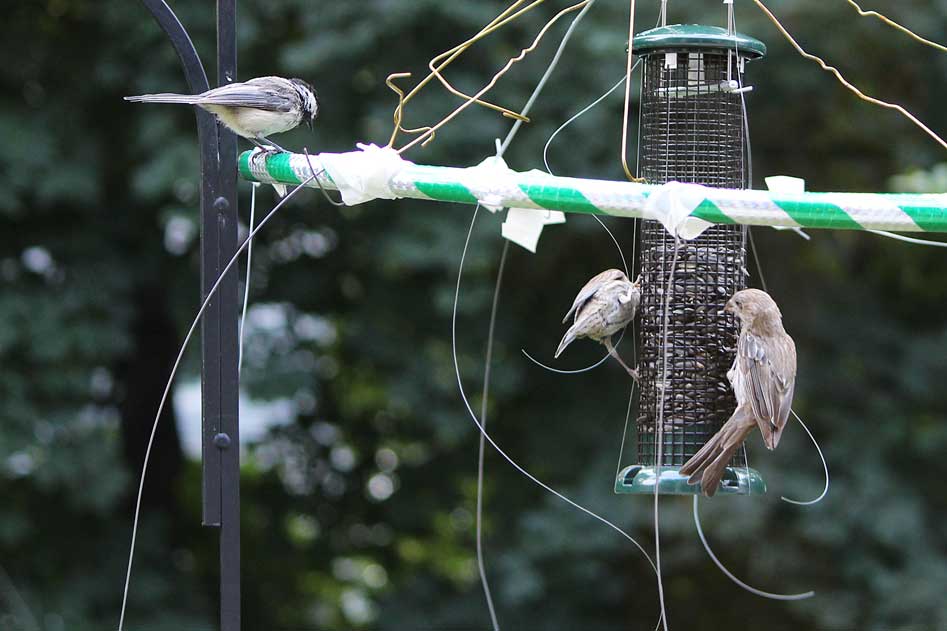

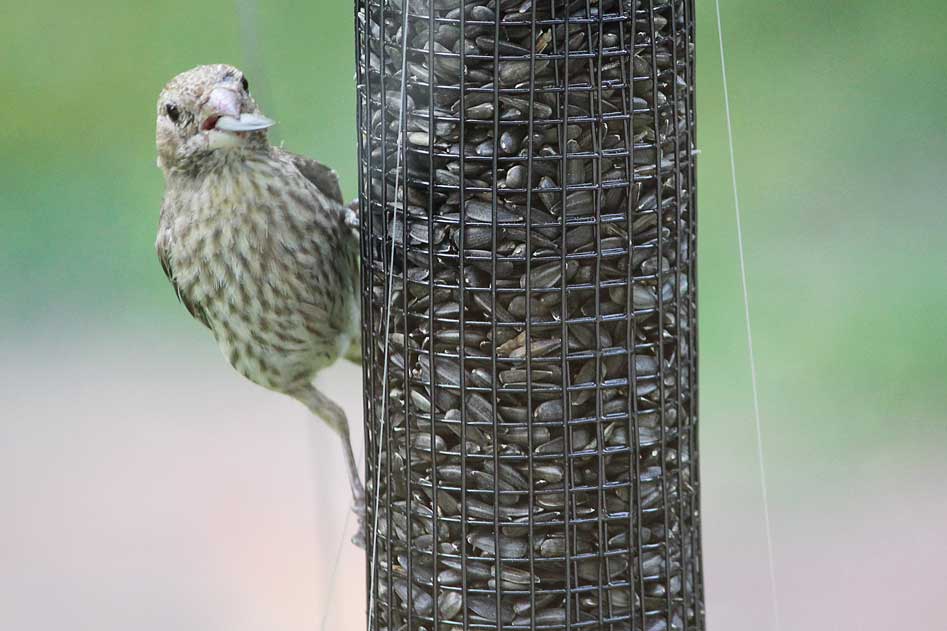
Unlike the little black-capped chickadee, the female house finch stayed and cracked open one sunflower seed after another.
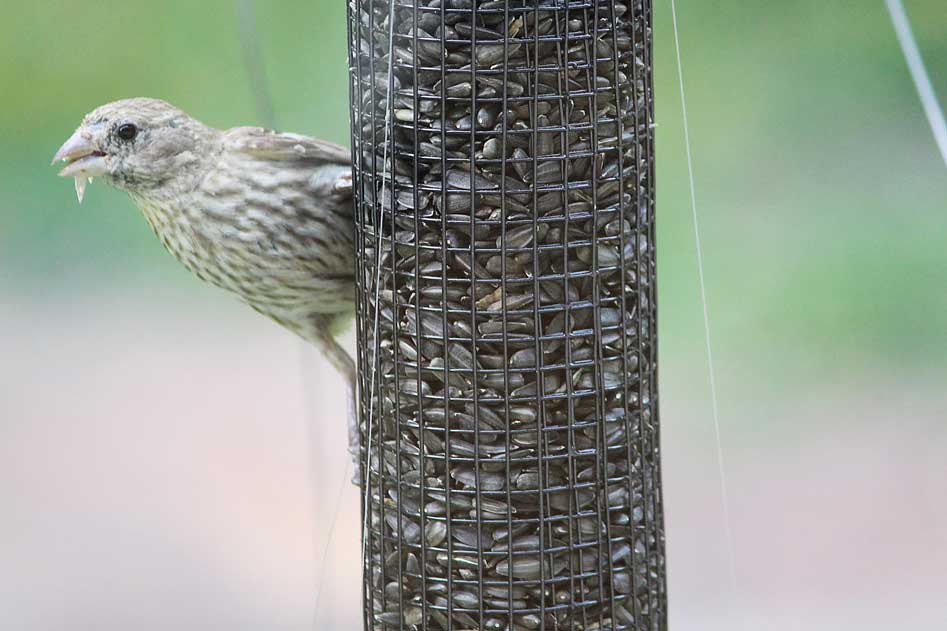
Meanwhile, the house sparrows stayed true to form, prefering to fight rather than eat. Two birds, four available feeding ports:
house sparrows will often engage in a territorial battle rather than allow another house sparrow to eat nearby.
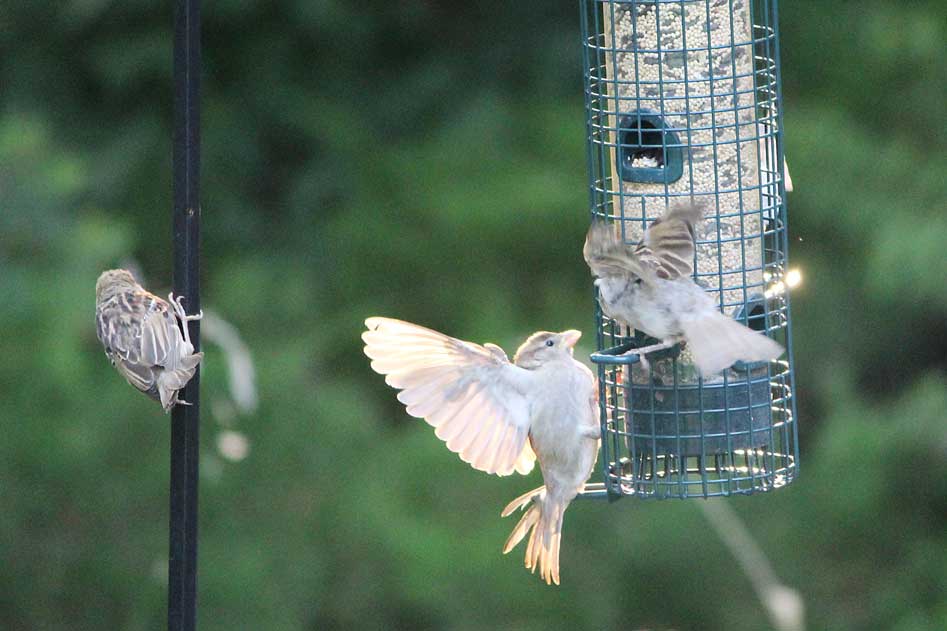

The backyard I had become accustomed to: relentless house sparrow noise, and an assortment of mourning doves, blackbirds,
rock doves, brown-headed cowbirds, and grackles. There was no chance for less-agressive birds like chickadees or house finches.
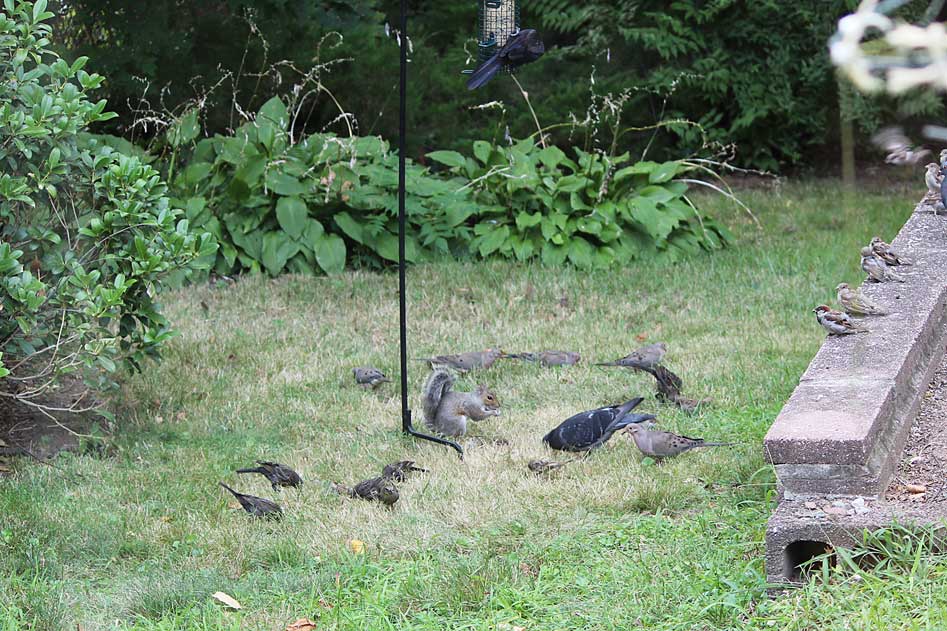
Saturday, 9 August 2014. Even more new developments in the backyard
Ready to add another new feeder. I've discovered that the hula-hoop "halo" does not deter every house sparrow. However,
I'll still put one up, as a reminder that this is a "no house sparrows allowed" feeding station. The new nyjer seed finch birdfeeder
is at the back; the tinfoil is another warning system to the house sparrows. What really seems to be deterring them is the
roll of 6 lb fishing line, front center, next to the duct tape.
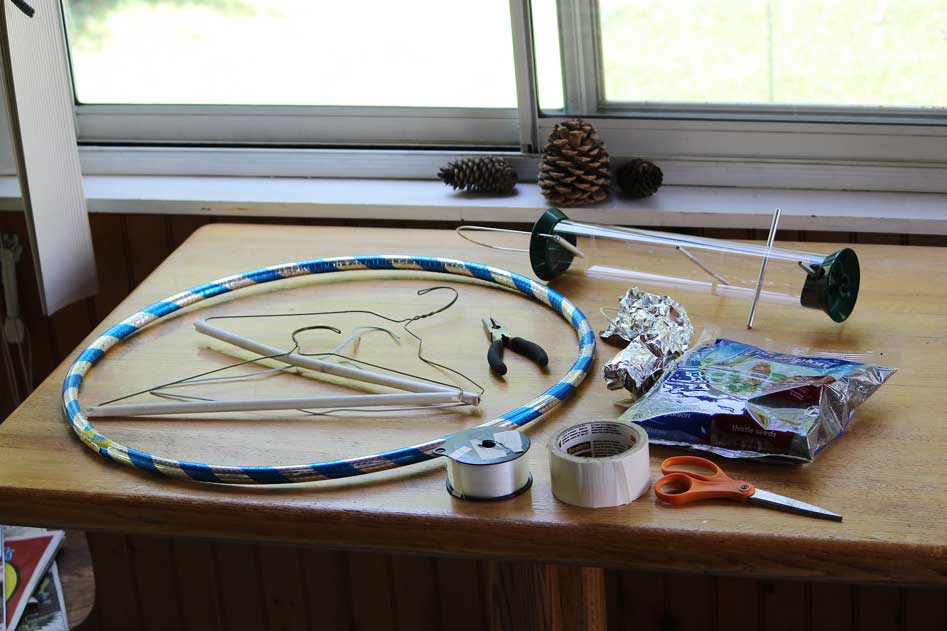
I have learned to fill just ONE feeder -- with the cheapest birdseed mix I can find -- for the house sparrows. As they eat, they
spill lots of seeds, giving lots to eat for the ground-feeders (squirrels, mourning doves, rock doves, blackbirds, grackles, and
brown-headed cowbirds).
The other thing I now do is to throw about two or three scoops of the cheapest birdseed mix on the ground, over a large area.
This keeps a lot of birds (and squirrels) busy for hours, looking for food in the grass.
These strategies do two things: create a marketing department to draw birds to our back yard (the house sparrows are constantly
making loud noises while
they eat) and a distraction (the house sparrows are successfully foraging, so less likely to explore
other birdfeeders).
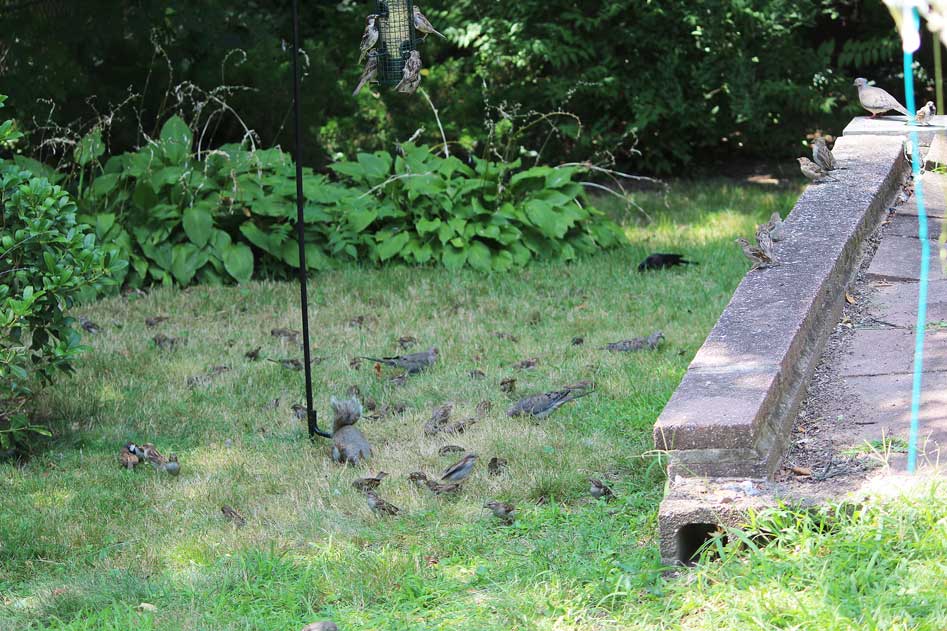
A new fine-screen birdfeeder that holds only black oil sunflower seeds. It hangs under a "halo", and several strands of
thin fishing line make the feeder repellent to house sparrows. That means only black-capped chickadees and house finches
have been eating the sunflower seeds. The fact that not a single bird is eating from the mesh feeder means success: NO
HOUSE SPARROWS are eating at the feeder.
The metal house-shaped suet feeder on the left was a dud. No birds tried it. (They had to discover that the food was accessible
only from underneath the feeder; supposedly a deterrent to "nuisance" birds.)
After some weeks, the metal house was taken down.
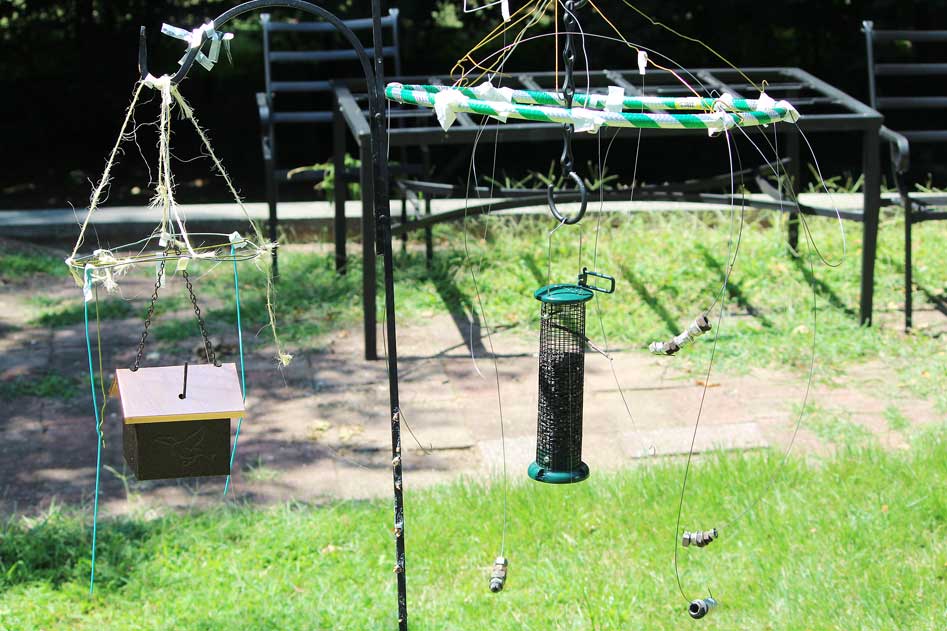
The newest feeder: a clear plastic tube with a few very tiny holes. It holds nyjer seed, a favourite of finches. It hangs under
a brand-new halo, with several strands of fishing line hung below the feeder and from the halo.
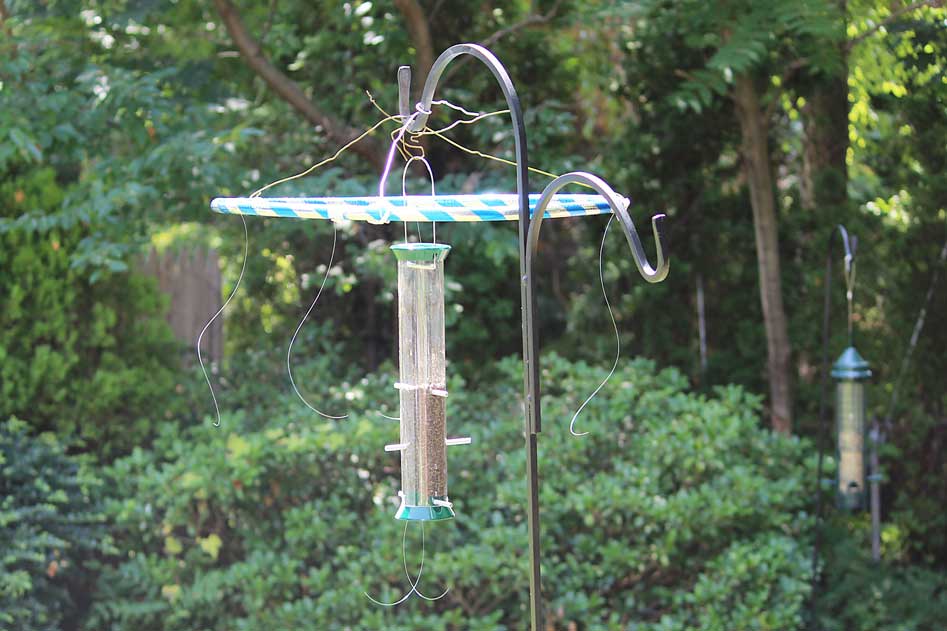
A BRAND NEW BIRD first appeared a few weeks ago, and today I was able to photograph it for the first time.
I watched it land on the plastic "Perky Pet" feeder and try to balance on the poorly-designed perches. It slid
and slipped and had to bend over a lot to eat. So I brought out one of the original "squirrel proof" steel feeders
and added some house-sparrow-repelling fishing line. Then I poured the "special finch mix" birdseed into it.
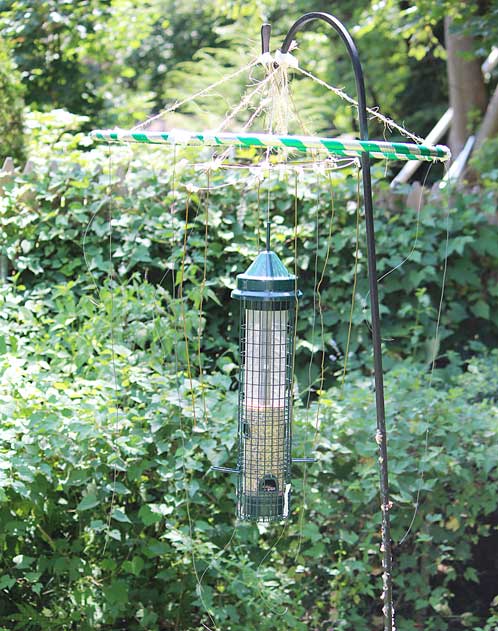
Success! The new arrival took to the feeder and allowed me to take its first photographs.
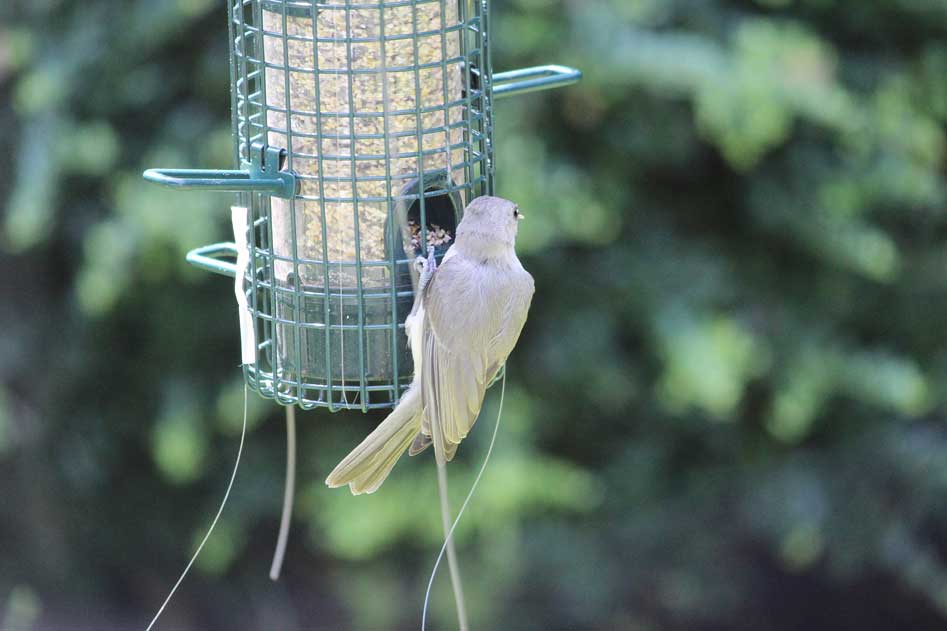
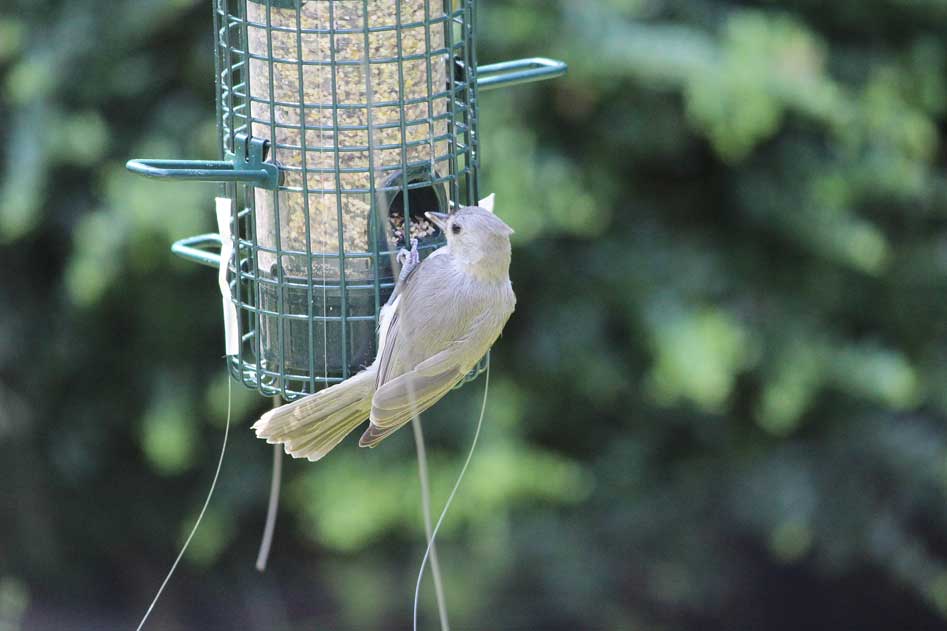
Like a chickadee, it used the perch to peck at seeds.
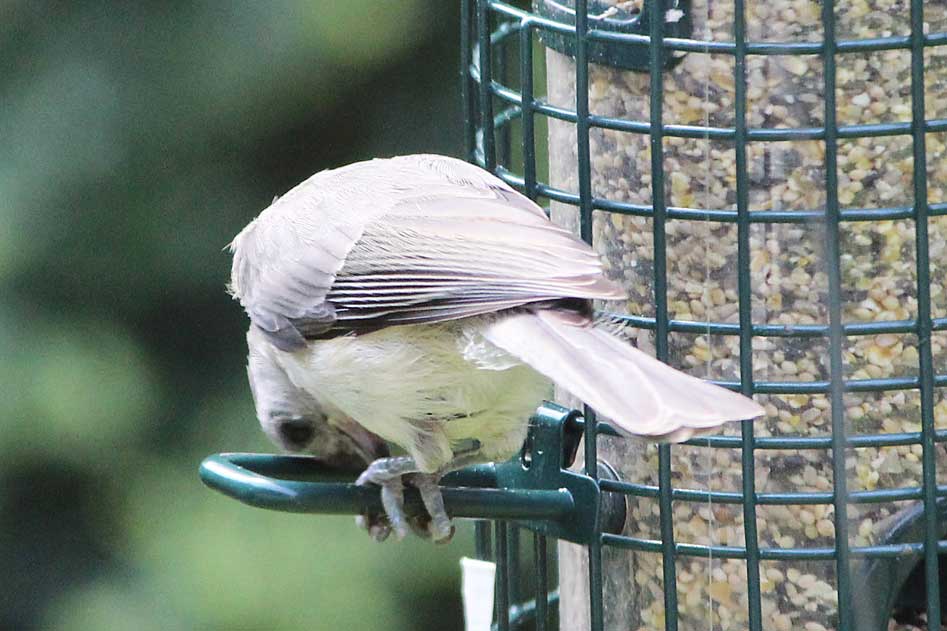
And here it is: a tufted titmouse. Because it's so uniformly grey, it looks a lot like a juniper titmouse, considered rare in our area.
It lacks the distinctive tufted titmouse features: black forehead and orange flanks.
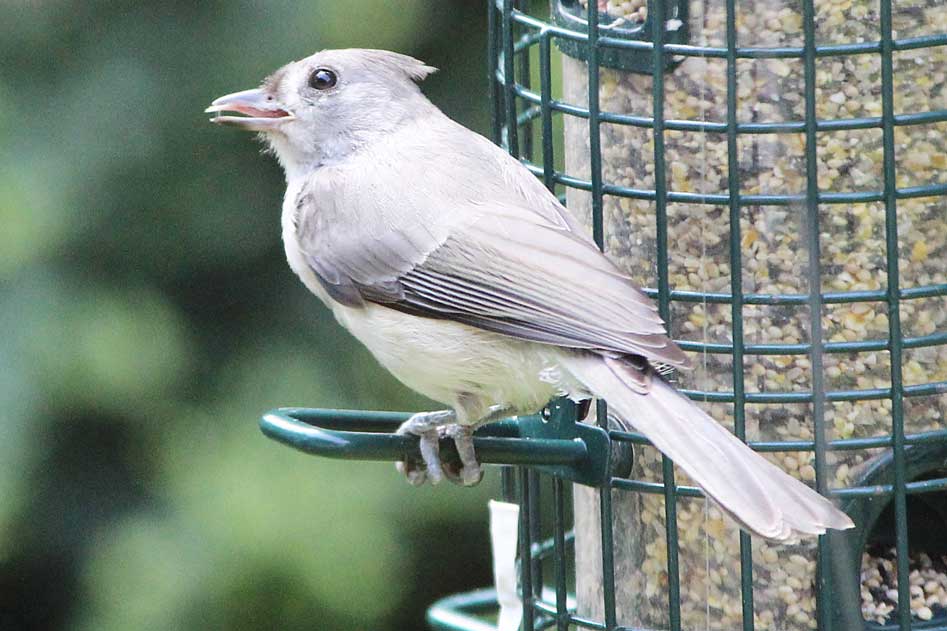
Success! Within a few minutes of putting up the new nyjer seed feeder, THREE female house finches checked it out.
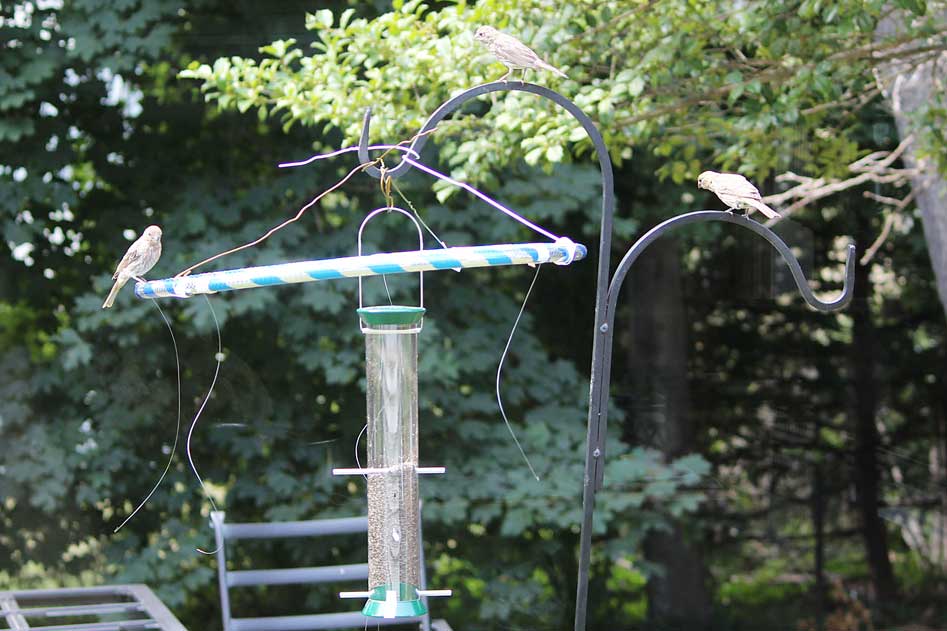
Two started eating from the tiny openings. They didn't stay very long, seeming to be happier eating sunflower seeds
or the "finch mix" at the other two halo feeders.
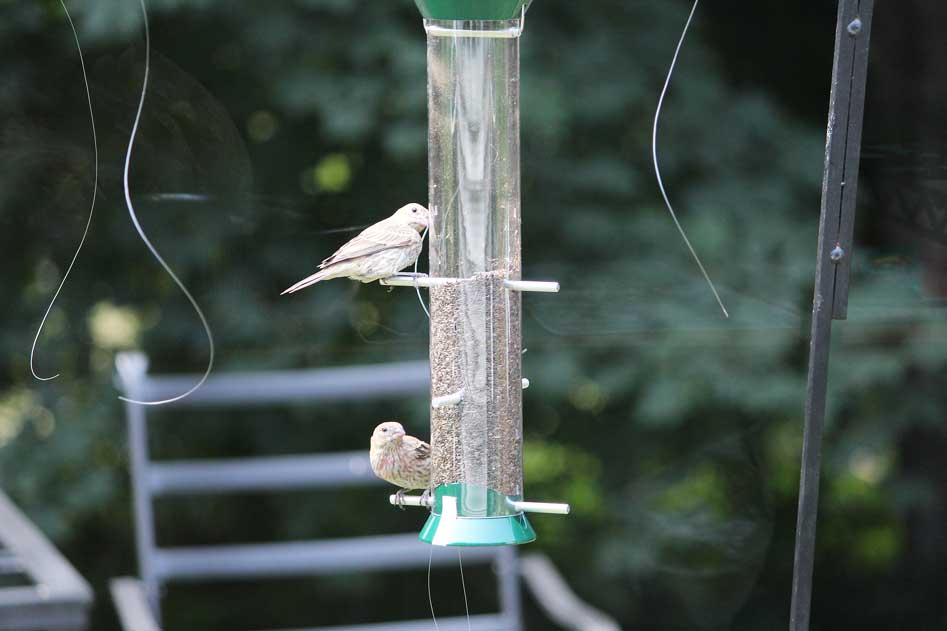
What's special about this photograph? A female house finch, eating quietly at a birdfeeder. That is, NO HOUSE SPARROWS!
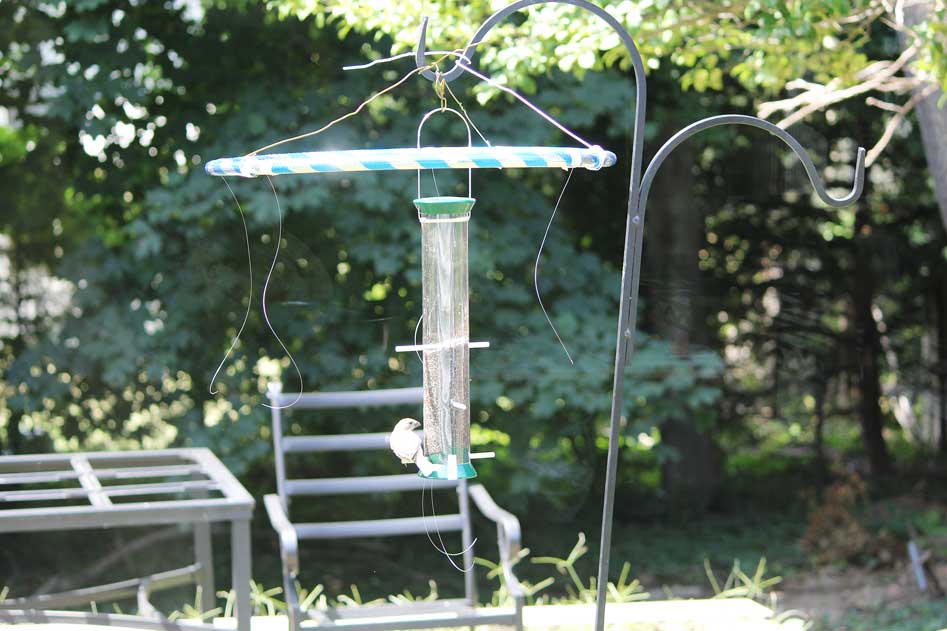
Success: two house finches eating at the squirrel-proof feeder, now retrofitted with fishing line to repel the house sparrows.
NO HOUSE SPARROWS!
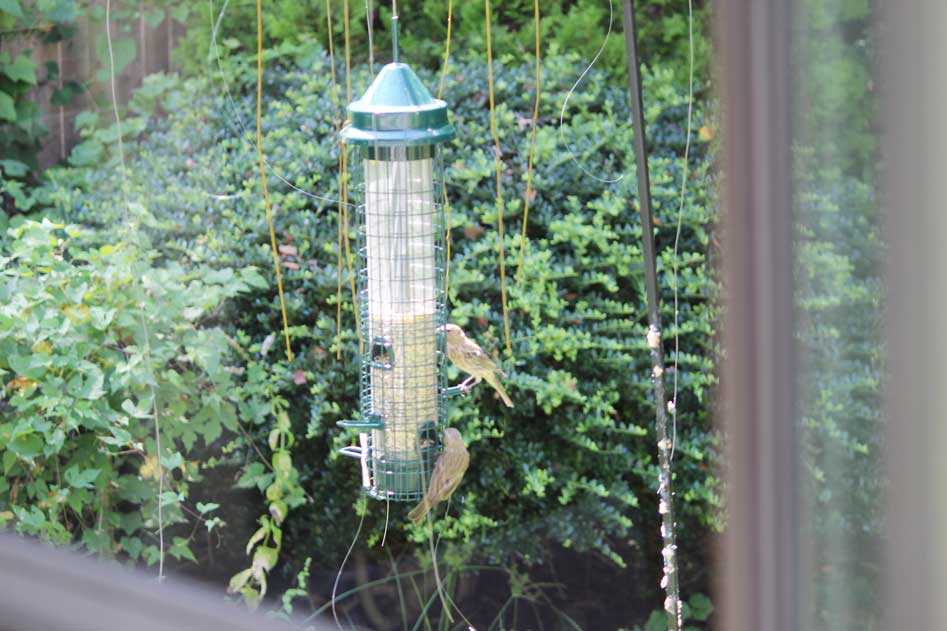
Female house finch at the new nyjer seed feeder. Later in the evening, about 7 p.m., a female house finch stayed on the
feeder and chowed down a lot of nyjer seed.
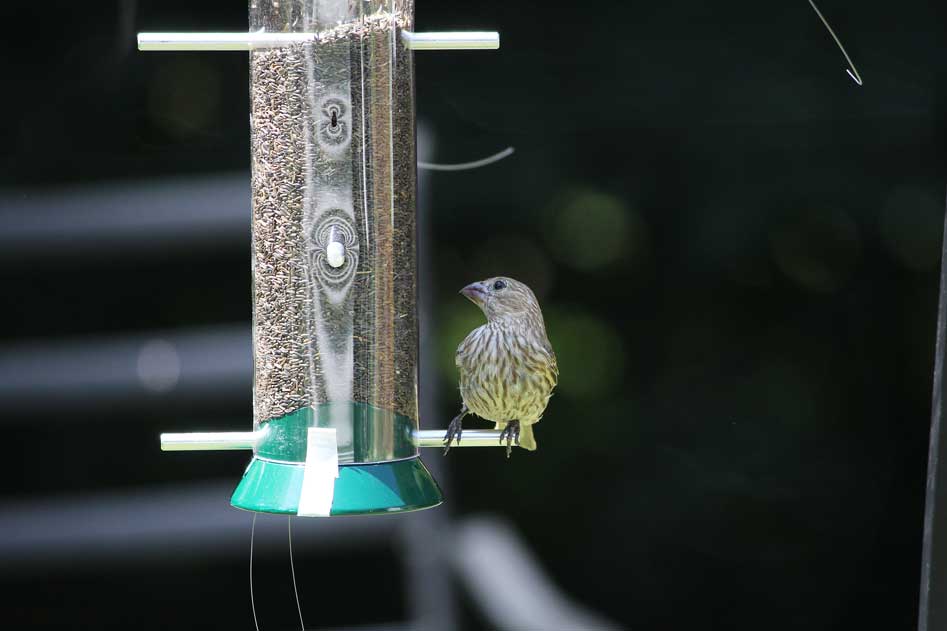
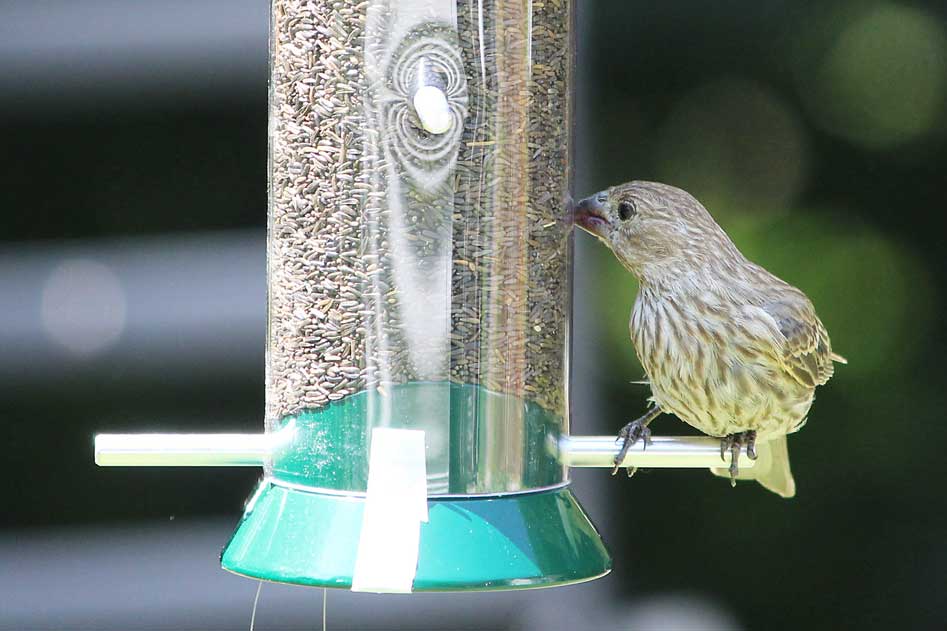
| Birds seen in our backyard | ||||||
1 |
2014-04-28 | Mourning Dove | _ | _ | _ | _ |
2 |
2014-04-28 | House Sparrow | _ | _ | _ | _ |
3 |
2014-04-28 | Goldfinch | _ | _ | _ | _ |
4 |
2014-05-02 | Northern Cardinal | _ | _ | _ | _ |
5 |
2014-05-02 | House Finch | _ | _ | _ | _ |
6 |
2014-05-03 | Common Grackle | _ | _ | _ | _ |
7 |
2014-05-09 | Brown-Headed Cowbird | _ | _ | _ | _ |
8 |
2014-05-09 | Downy Woodpecker | _ | _ | _ | _ |
9 |
2014-05-09 | Black-Capped Chickadee | _ | _ | _ | _ |
10 |
2014-05-09 | Red-Winged Blackbird | _ | _ | _ | _ |
11 |
2014-06-13 | Blue Jay | _ | _ | _ | _ |
12 |
2014-06-20 | Rock Dove (Pigeon) | _ | _ | _ | _ |
13 |
2014-07-19 | Starling | _ | _ | _ | _ |
14 |
2014-08-09 | Tufted Titmouse | _ | _ | _ | _ |